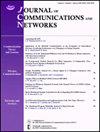大规模确定性网络时隙分配和流量引导的联合优化
IF 3.2
3区 计算机科学
Q2 COMPUTER SCIENCE, INFORMATION SYSTEMS
引用次数: 0
摘要
近来,时间敏感型服务已从传统的工业控制系统扩展到更多场景。一些时间敏感型应用,如远程手术、自动驾驶、增强现实(AR)等,要求数据传输具有确定性的端到端延迟和抖动。确定性网络(DetNet)作为一种在广域网(WAN)中提供确定性服务的有前途的技术被提出。DetNet 通过为时间敏感的数据流指定一定的路由路径和传输时隙,来保证确定性的端到端延迟和抖动。然而,如何在联合分配传输时隙的同时有效地引导时间敏感流仍是一个未决问题。现有的流量调度算法仅限于局域网(LAN)场景,没有考虑大规模网络中传播延迟的影响。为此,我们研究了时隙分配和流量转向的联合优化,同时考虑了广域网链路的传播延迟。我们的目标是在所需端到端延迟的约束条件下,最大化成功部署的时间敏感流的数量。因此,我们将所研究的问题表述为一个整数线性规划(ILP)模型。由于事实证明这是一个 NP 难问题,我们设计了一种启发式算法,名为基于遗传的确定性网络流量调度(GDNTS)。通过 GDNTS 中染色体的进化,可以获得部署了最多时间敏感流的解决方案。与基准算法相比,大量仿真结果表明,GDNTS 平均提高了 22.85% 的时间敏感流部署数量。本文章由计算机程序翻译,如有差异,请以英文原文为准。
Joint optimization of time-slot allocation and traffic steering for large-scale deterministic networks
Recently, time-sensitive services have expanded from traditional industrial control systems to more scenarios. Some time-sensitive applications, such as remote surgery, autonomous driving, augmented reality (AR), etc., require deterministic end-to-end delay and jitter in data transmission. deterministic network (DetNet) is proposed as a promising technology for providing deterministic service in wide area networks (WAN). DetNet guarantees deterministic end-to-end delay and jitter by specifying a certain routing path and transmission time-slots for timesensitive flows. However, how to efficiently steer time-sensitive flows while jointly allocating transmission time-slots is still an open problem. Existing flow scheduling algorithms are limited in the scenarios of local area networks (LAN), and do not consider the impact of propagation delay in large-scale networks. To this end, we study the joint optimization of time-slot allocation and traffic steering, while considering the propagation delay of WAN links. Our objective is to maximize the number of successfully deployed time-sensitive flows under the constraints of required end-to-end delay. Accordingly, we formulate the studied problem as an integer linear programming (ILP) model. Since it is proved to be an NP-hard problem, we design a heuristic algorithm named genetic-based deterministic network traffic scheduling (GDNTS). The solution with the largest number of deployed time-sensitive flows can be obtained from the evolution of chromosomes in GDNTS. Compared with the benchmark algorithms, extensive simulation results show that GDNTS improves the deployed time sensitive-flows number by 22.85% in average.
求助全文
通过发布文献求助,成功后即可免费获取论文全文。
去求助
来源期刊
CiteScore
6.60
自引率
5.60%
发文量
66
审稿时长
14.4 months
期刊介绍:
The JOURNAL OF COMMUNICATIONS AND NETWORKS is published six times per year, and is committed to publishing high-quality papers that advance the state-of-the-art and practical applications of communications and information networks. Theoretical research contributions presenting new techniques, concepts, or analyses, applied contributions reporting on experiences and experiments, and tutorial expositions of permanent reference value are welcome. The subjects covered by this journal include all topics in communication theory and techniques, communication systems, and information networks. COMMUNICATION THEORY AND SYSTEMS WIRELESS COMMUNICATIONS NETWORKS AND SERVICES.

 求助内容:
求助内容: 应助结果提醒方式:
应助结果提醒方式:


